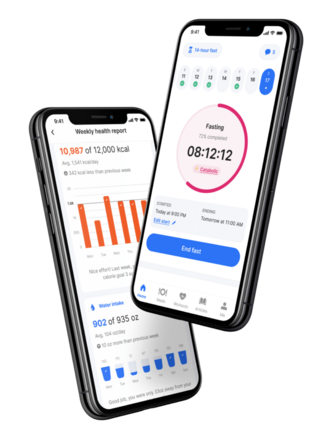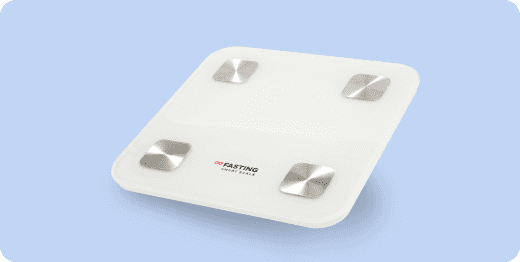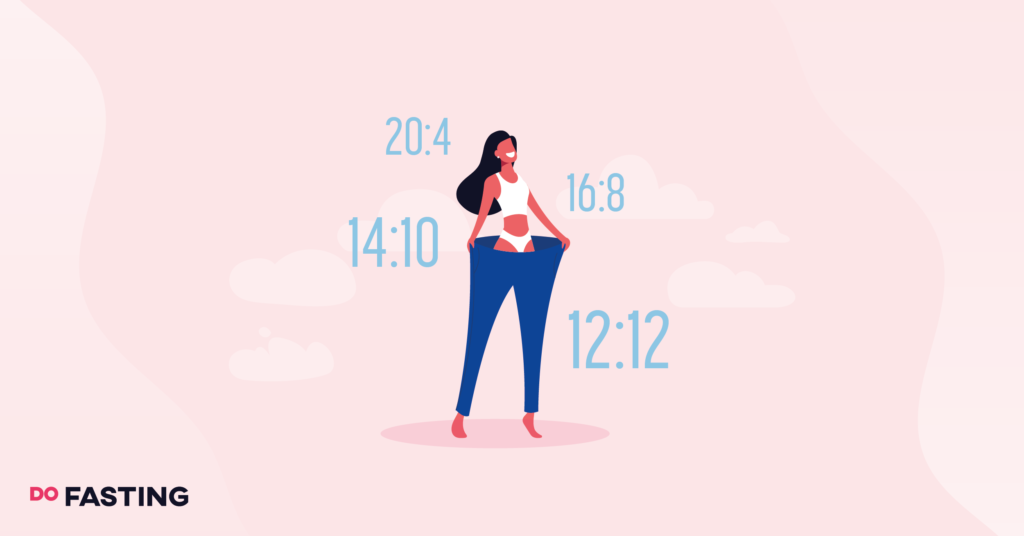Contents
What Is Dry Fasting?
Dry fasting is when you can’t eat or drink during the fasting periods. You can’t have water or zero-calorie fluids during this time either. This fasting method is supposed to reduce blood pressure and restrict your calorie intake for effective weight loss results.
The absence of water in the body causes it to use every available source of energy. Your metabolism focuses on burning fat from stubborn areas like your face, arms, stomach, and thighs. You can also choose eating windows that are best for your diet.
Take a
1-minute quiz
and discover how much weight you can lose with DoFasting!

The Difference Between Dry Fasting and Water Fasting
Many people try water fasting to lose weight – a type of fast that requires you to only drink water during non-eating periods. This is different from dry fasting as it allows you to have a drink throughout the day, no matter what time it is.
Dry fasting can actually intensify the cleansing process of traditional water fasting. This is due your body using toxins for energy. The metabolism also speeds up the process of gaining water from fat cells, eventually balancing cholesterol levels.
3 Types of Dry Fasting
There are three types of dry fasting methods you can choose from, depending on your weight loss goals. Some of them are more challenging for fasting beginners.
Here are 3 types of dry fasting that promote weight loss:
1. Intermittent Dry Fasting
Intermittent dry fasting is when you abstain from eating or drinking for a certain amount of time. This could be 12–16 hours each day or 24 hours once a week. People usually choose eating windows that are suitable for their current body weight.
The 16/8 fasting duration requires you to eat meals for only 8 hours in the day. Those 16 hours will stop you from consuming any food or drinks. Beginners of intermittent fasting usually try this pattern first, as it’s much easier to manage on a schedule.
Other challenging methods include the 20/4 eating pattern. People also call this the warrior diet because it has a strict fasting window. You need to fast for 20 hours and only eat for 4 hours. During those 20 hours you can’t have any food or water.
2. Prolonged Dry Fasting
Now, if you’re wanting more challenges, the prolonged dry fasting method can be tough. Fasting for long periods of time (usually around 48 hours) will seriously limit calorie restriction. This is something you should practice after trying intermittent dry fasting.
Ketosis can happen 12-16 hours into a fast, so people tend to do prolonged dry fasting for 2 days to see weight loss results. However, you should never exceed 72 hours, as the body needs water to properly function throughout the day.
3. Absolute Dry Fasting
Absolute dry fasting isn’t a very popular method as it can make you feel uncomfortable and gross. You can’t eat food or drink, but you also can’t touch water at all. This means no showers, brushing your teeth, washing your hands, or cleaning surfaces.
Some people believe that our skin can absorb water, so they refuse to touch any liquids during the fast. However, skin is water-resistant, making this theory false. This method isn’t worth doing if you don’t wish to cut out your normal daily activities.
Why Does Dry Fasting Work?
You might be wondering how a dry fast actually works. It might seem intimidating at first, but your body will feel similar effects to a ketogenic diet.
One of the biggest concerns with dry fasting is dehydration. Not drinking enough fluids is always going to sound dangerous. But don’t worry, because the human body can balance water on its own. The digestive tract usually holds water that fuels your organs.
Let’s take a look at how a dry fast works:
Slows water turnover rate
The water turnover rate in your body is around 5-10% of total body water per day. Dry fasting can slow this down due to the lack of water you’re consuming. This makes your body reduce water through urination and sweating, maintaining suitable water levels.
The Antidiuretic Hormone (ADH) reabsorbs water
Everyone has the Antidiuretic Hormone (ADH) that works to dilute your blood with stored water instead of urine. This hormone travels to the kidneys and provides the body with internal hydration – a great way of maintaining your circulatory system.
ADH means you’ll have more water retention during the fast. This ensures you don’t experience signs of dehydration when not drinking for hours. Just remember not to go over 72 hours without liquids, as this could damage your health long-term.
The body can make water from dietary fats
Your body has a way of turning nutrients into metabolic water. If you eat high-fat foods during eating windows, you can retain extra water from dry fasting. This is enough to cover water lost through respiration, sweating, and other small bodily functions.
10 Ways Dry Fasting Can Benefit Your Health
A dry fast has many benefits that can improve your overall health and weight loss progress. Periodic fasting has always been popular to burn off pounds.
Here are 10 ways dry fasting can strengthen the body:
1. Helps you lose weight
The intermittent fasting method can reinforce positive weight loss results by altering your eating habits. A calorie restriction in your diet means you’re consuming less calories than your body needs, encouraging it to burn stubborn fat for energy.
Dry fasting completely cuts food and drink for a long period of time, so your body is bound to drop some pounds. Since the metabolism relies on food consumption for fuel, it takes nutrients from your fat, abnormal cells, and toxins that damage immune cells.
2. Protects your brain functions
Fasting in general can release the human growth hormone (HGH) that changes your metabolism to burn fat and not carbs or protein. This means that protein is used for muscle repair, regeneration of new cells, and brain-cell functioning.
HGH is great for improving your cognitive function. Things such as memory, mental awareness, and motivation have been strengthened through a dry fast.
3. Improves your immune system
Dry fasting for at least 48 hours allows the body to produce new white blood cells – preventing infections and strengthening your immune system.
Abstaining from food and water means decreased blood glucose levels, leading to the regeneration of stem cells. This is because your body needs new cells when eating glucose and fat stores. Your immune system will instantly be new and clean.
4. Promotes healthy skin
Your skin produces sebum – an oily substance that prevents moisture from escaping the face. Fasting ensures that your skin can actually breathe once the substance is no longer present. Many people find that their face is both smooth and plump after fasts.
5. Helps with bone health
A dry fast can reduce the risk of bone and joint diseases. Not eating for certain periods of time can regulate the hormones in your body. Combining this with healthy eating during your non-fasting windows, you consume foods with high Vitamin D.
Calorie restriction can potentially slow down the progress of age-related wear to your bones. This hinders degenerative changes and prevents conditions like osteoporosis, osteomyelitis, rheumatoid arthritis, and lower back pain for older adults.
6. May lower blood sugar
Fasting can reduce your blood sugar levels in 2-4 weeks of cutting down on food and beverages. Repeated fasting may keep body glucose under control and help promote improved concentration, better energy, and sustainable weight management.
7. Could prevent diabetes
Maintaining your glucose levels is a great way of preventing diabetes – a health condition that produces too much blood sugar. Intermittent fasting may encourage increased insulin sensitivity, helping the body to regulate sugar levels.
8. Helps with cholesterol
Dry fasting might decrease your low-density lipoprotein (bad cholesterol) and improve how the metabolism breaks down sugar. This can reduce the risk of weight gain through excess fat storage, but it’s still important to consume healthy, low-calorie foods.
Good cholesterol is supposed to stay under 200 mg/dl for adults. Going above this could limit natural blood flow. Intermittent fasting can increase those levels and make sure your body is healthy enough to continue normal functions.
9. May prevent heart disease
Any type of fasting, including dry, can lower your blood pressure and strengthen blood vessels. This will prevent coronary heart disease, strokes, heart failure, cardiovascular disease, and other serious complications that can derive from high blood pressure.
Fasting can improve heart health by reducing cholesterol and insulin resistance – two things that contribute to a bad circulatory system. To further strengthen your heart during weight loss, avoid smoking and go outside for some physical activity.
10. Helps you reach your goals faster
Cutting out food and drinks will certainly kick-start your metabolism. The reduction in fat storage comes from the lack of energy. Your body mass index decreases after dry fasting, so this will help you reach your fitness goals in less than a few weeks.
Start Dry Fasting in 5 Easy Steps
Now, you might feel ready to try intermittent fasting, but you need to understand the steps. Preparation is super important for reducing potential stress on your body.
Here are 5 easy steps to start a dry fast:
Step 1: Get into ketosis
Your body will release ketones once you start a dry fast, since you’re cutting out food and beverages. These ketones act like energy sources when the metabolism needs fuel. A low-carb diet can stop your body from burning carbohydrates instead of fat.
Intermittent fasting is a way to adapt to fat burning, which leads to fewer hunger cravings on your weight loss journey. A reduced appetite means you won’t snack or binge eat during eating windows. This can help produce faster results when losing weight.
The keto diet is worth trying if you want to get nutritional intake and fall into ketosis during dry fasting methods. Many people start losing fat in 2-4 of starting this diet. Just make sure to eat low-carb foods that have high amounts of healthy fats.
Step 2: Introduce short-term water-only fasting
Beginners of intermittent fasting should try the 16/8 method, as you have more time in the day to eat. This can help you feel prepared when fasting for long periods. The 12-hour fast is another good place to start before advancing onto the dry fast.
Also, drink water before cutting out food and drinks. This ensures you’re fully hydrated before cutting out fluids completely. Daily water intake for adults should be around 8 cups for women and 10 cups for men, so don’t forget this important step.
Step 3: Get an app to help you get started
New lifestyle changes can seem intimidating to some people, but there are certain apps that will guide you through the process. Dietary tracking applications monitor your time-restricted eating and tell you when a dry fast starts and ends.
One helpful app is DoFasting, which gives you plenty of tracking options regarding diet and exercise plans. There are plenty of intermittent fasting methods to go through when finding something suitable for your dietary needs and weight loss goals.
You can also use DoFasting to document how much water you’re drinking during eating windows. This prevents problems like urinary tract infections, severe dehydration, and persistent hunger on the dry fast, so it’s worth drinking water and tracking it.
Take a
1-minute quiz
and discover how much weight you can lose with DoFasting!

Step 4: Start eliminating water from your fasting windows
Now might be the hardest part of your intermittent fasting. You need to stop consuming water for at least 24 hours. If you consume liquid of any kind, this dry fasting won’t work. Remember that your body is capable enough of producing metabolic water.
You don’t need to do this step straight away if you don’t feel comfortable. Give yourself smaller fasting windows and build your way up from there. Consider not having water for 12 hours and see how that feels, or go straight into a 48-hour dry fast.
Step 5: Begin dry fasting
The final step focuses on choosing your type of intermittent fasting. If you have broad weight loss goals, follow dry fasting to encourage the fat-burning stage. During this point, you need to abstain from any foods or liquids and only eat after fasting.
Hydration during the eating windows is key
One thing to remember is that you should increase your water intake during eating windows. Not consuming enough liquids after fasting could lead to serious dehydration, brain swelling, kidney stones, and metabolic syndrome that disrupts weight loss.
Two Main Stages Your Body Will Go Through
Your body goes through many phases once you cut water and food intake. Healthy adults usually have 2 main stages that happen during dry fasting.
Let’s take a closer look at what your body does:
Using glycogen stores for energy
A dry fast or prolonged fasting of any type can encourage your body to consume glycogen storage. The molecules from food and beverages are often stored in your liver. From this location, your metabolism can find energy to keep on functioning.
Glycogen storage can be depleted in around 24 hours after starting the fast. This is why you should dry fast for longer than one day. Your body will then have a chance to burn any hard fat surrounding your organs like the liver and kidneys.
Start burning fat for energy
After getting through that glycogen storage, your body starts breaking down protein and fat for energy instead. This is how you lose those pounds on a fasting schedule. You might notice a change in your body weight after a few weeks of intermittent fasting.
The fat-eliminating process usually occurs approximately 12 hours into fasting. This may escalate after 16 hours of no food and drink. You can easily achieve this by conducting regular fasting this is both safe and free of risk factors.
Side Effects to Be Expected With Dry Fasting
A dry fast will always have side effects that occur during the first few hours of fasting. You might notice small changes, like headaches, that don’t completely disrupt normal daily activities. However, not everyone is about time-restricted feeding.
One side effect is dehydration that only happens when a person doesn’t drink enough during eating windows. This can lead to kidney stones, low blood pressure, severe exhaustion, muscle cramps, extreme thirst, dry mouth, and confusion.
To avoid dehydration, gulp down lots of water before and after fasting periods. A dry fast becomes harmful when you become physically sick. Make sure not to do strenuous exercise during a dry fast, as this can also trigger dehydration.
You might also experience constipation from not consuming nutrients. This should disappear once your body has adjusted to the eating pattern. You can eat fiber-based foods after fasting to relieve constipation symptoms and cleanse the gut.
Never go 3 days without water, since this may cause internal damage. You should only fast for around 48 hours before consuming liquids again.
Conclusion
Dry fasting is a good way of dropping pounds in a sustainable length of time. Remember that drinking water is important and you need to get your daily intake before and the fasting period. The human body needs water, so don’t cut it out completely.
Take a
1-minute quiz
and discover how much weight you can lose with DoFasting!

See how DoFasting will improve your life
Find out what works for you with this 60-sec quiz approved by our experts and get your personal revolutionary fasting assistant.
Start the Quiz















